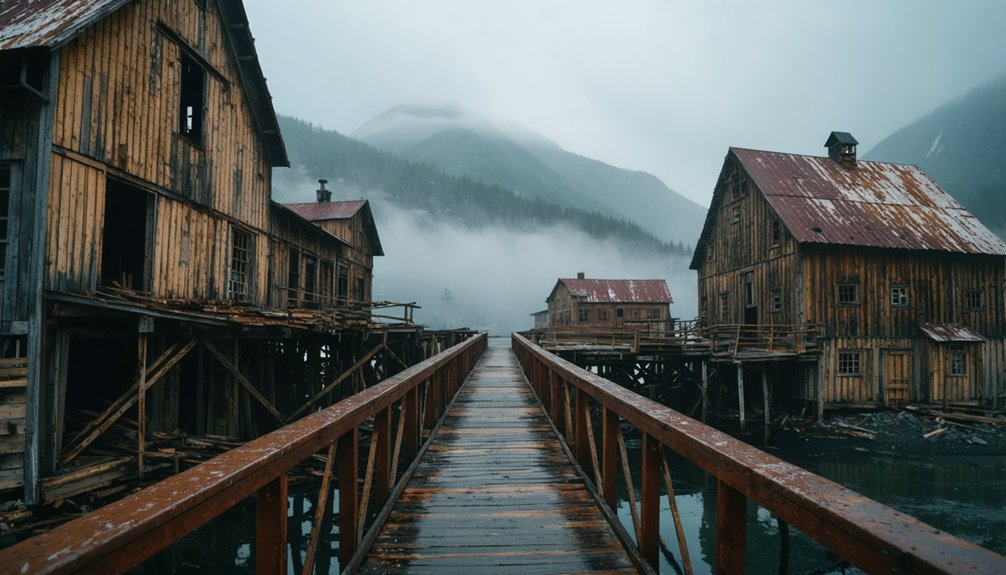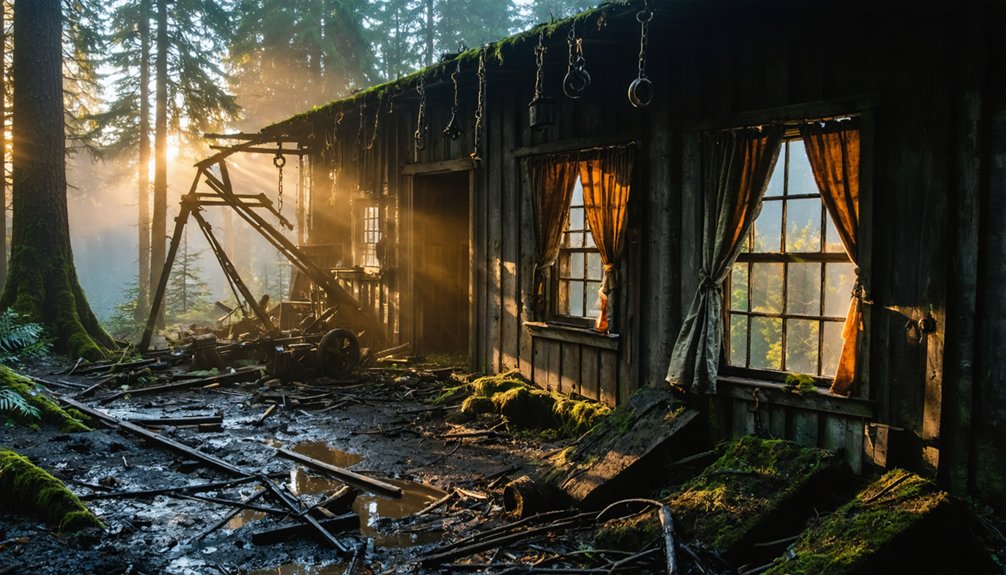You’ll discover America’s most fascinating abandoned logging towns across three distinct regions. Quick, Michigan offers ghostly foundations along the Pigeon River where sawmills once thrived until 1917. Livermore, New Hampshire invites exploration among crumbling stone structures accessible by a scenic 1.5-mile hike. Bodie, California preserves 110 buildings in “arrested decay” at 8,379 feet elevation, where mining and logging heritage freeze-frames the past. These forgotten communities hold untold stories beneath their weathered remains.
Key Takeaways
- Quick, Michigan features preserved remnants of logging railroad tracks and sawmill foundations from operations that ended in 1917.
- Livermore, New Hampshire showcases crumbling stone structures of a logging community established by Boston lawyers in 1876.
- Bodie, California maintains 110 buildings in “arrested decay,” offering an authentic glimpse into 19th-century mining and logging life.
- Abandoned logging towns provide historical insight into America’s timber industry through preserved infrastructure and living conditions.
- These ghost towns are accessible to visitors, with Livermore requiring a 1.5-mile hike and Bodie preserved as a California Historical Landmark.
Quick, Michigan: The Vanished Logging Haven of Otsego County
Deep in the heart of Otsego County, one mile south and seven miles east of Gaylord, lies what was once Quick, Michigan—a memorial to America’s voracious appetite for timber during the late 19th century.
You’ll find nothing but ghostly foundations where a vibrant logging heritage once thrived along the west branch of the Pigeon River. Quick’s sawmills and shingle production fueled the northern Michigan economy until 1917, when harvestable timber finally ran out. Workers were typically paid modest daily wages similar to those in other logging communities of the era. The rhythmic clanking of mill machinery has long been replaced by forest silence. Visitors today might find remnants of the logging railroad tracks that once transported massive timber loads from the surrounding forests.
Community life centered around the six-month schoolhouse, church services held in logging camps, and the general store where workers gathered after exhausting shifts.
Like many boom-and-bust settlements, Quick’s residents eventually scattered to the winds, leaving behind a memorial to an industry that carved civilization from wilderness before moving on.
Livermore, New Hampshire: A Pristine Ghost Town in White Mountain National Forest
Nestled within the pristine wilderness of White Mountain National Forest, Livermore represents one of New Hampshire’s most compelling logging ghost towns, where nature has reclaimed what Harvard-educated Boston lawyers established in 1876.
A forgotten logging empire where wilderness now silently consumes the ambitious dreams of educated men.
The Saunders family transformed this remote location into a thriving community through their Grafton County Lumber Company, until devastating floods in the 1920s began its decline toward abandonment by 1949.
- Explore crumbling stone foundations of the once-mighty sawmill that employed most residents
- Discover remnants of the Sawyer River Railroad, including remarkable stone bridges now overrun by forest
- Follow overgrown paths where apple trees from residents’ gardens still occasionally bear fruit
- Witness how a community of 200 souls vanished, leaving only whispers of Livermore history for ghost town exploration
A major smallpox epidemic struck the town during its heyday, adding to the challenges faced by this isolated logging community.
Located approximately 16 miles Northwest of North Conway, the ghost town is accessible via a 1.5-mile hike along an old dirt road where visitors can see brick structures and skeletal foundations of the former settlement.
Bodie, California: Where Mining and Logging Heritage Stands Frozen in Time
Standing as California’s most iconic ghost town, Bodie offers visitors a remarkable glimpse into America’s gold rush era, where time appears to have stopped in the late 19th century. Founded in 1859 after W.S. Bodey’s gold discovery, this boomtown exploded to nearly 10,000 residents by 1879, producing over $38 million in precious metals during its heyday.
Today, you’ll find 110 buildings preserved in “arrested decay,” their interiors untouched since abandonment—a genuine portal to Gold Rush history. The town was officially abandoned in 1962 and became a California Historical Landmark. Visitors should be cautious about taking souvenirs, as many report experiencing strange misfortunes afterward. Peek through windows of the Methodist Church, schoolhouse, and saloon for an authentic glimpse of frontier life.
After mining ceased in 1942, Bodie converted from forgotten relic to National Historic Landmark in 1961. Its wooden structures and mountain isolation at 8,379 feet have helped maintain its status as America’s best-preserved mining ghost town.
Frequently Asked Questions
Are Ghost Logging Towns Safe to Visit With Children?
No, they’re generally unsafe for children due to hazards like unstable structures and toxic materials. You’ll need careful planning for family safety if you’re seeking child friendly activities with historical depth.
What Permits Are Needed to Explore Abandoned Logging Settlements?
Ever wonder about our forgotten industrial past? You’ll need federal Special Use Permits, state entry passes, or private landowner permission. Exploration regulations protect these sites’ historical significance while preserving our freedom to connect with America’s timber heritage.
When Is the Best Season to Photograph Logging Ghost Towns?
Fall offers you the best lighting and seasonal colors for photographing logging ghost towns. You’ll capture the architectural nuances bathed in golden hour light while vibrant foliage frames these forgotten industrial monuments.
Can Metal Detectors Be Used at Abandoned Logging Sites?
Like a miner seeking gold in forgotten streams, you can use metal detectors, but you’re walking a legal tightrope. Historical artifacts over 50 years old require permits—respect preservation laws while pursuing your detecting tips.
Are There Guided Tours Available for Remote Logging Ghost Towns?
Guided experiences at remote logging ghost towns are limited. You’ll find tour options primarily at state parks or through historical societies, where you’ll discover architectural remnants that showcase America’s rugged logging heritage.
References
- https://www.petoskeynews.com/story/news/local/gaylord/2015/04/07/ghost-towns-left-behind-by-the-earliest-loggers/45205943/
- https://en.wikipedia.org/wiki/Wikipedia:WikiProject_Ghost_towns
- https://www.whitemountainhistory.org/abandoned-towns
- https://www.geotab.com/ghost-towns/
- https://www.christywanders.com/2024/08/top-ghost-towns-for-history-buffs.html
- https://en.wikipedia.org/wiki/Lists_of_ghost_towns_in_the_United_States
- https://en.wikipedia.org/wiki/Ghost_town
- https://www.atlasobscura.com/lists/americas-best-preserved-ghost-towns
- https://mikelbclassen.com/tyoga-historical-pathway-ghost-town-alger-county-michigan/
- https://kids.kiddle.co/List_of_ghost_towns_in_Michigan



